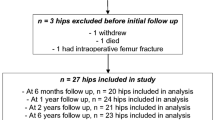Abstract
The concept of an extensive hydroxyapatite (HA) coating for the fixation of a tapered femoral stem (Corail®) was introduced 25 years ago in the hope that we could achieve durable biological fixation while preserving normal periprosthetic bone activity. The value of uncemented fixation using HA-coated implants is now widely admitted. However, the characteristics of implant coating and more specifically its extent still remain a subject of debate or even controversy. This prospective study conducted over a 20-year period has greatly contributed to demonstrating the reliability of the Corail® prosthesis, in terms of functional abilities, radiographic evidence and global survivorship. A full HA coating applied on a straight and proximally flared stem induces substantial short-, mid- and long-term benefits without any deleterious effects reported. Modifications of the bone pattern have been strictly limited: slight resorption at the calcar level, absence of cortical hypertrophy and alleged stress shielding. The radiological “silence” is one of the paramount facts clearly demonstrated.




Similar content being viewed by others
References
Al Hertani W, Waddell JP, Anderson GI (2000) The effect of partial vs. full hydroxyapatite coating on periprosthetic bone quality around the canine madreporic femoral stem. J Biomed Mater Res 53:518–524
Baltopoulos P, Tsintzos C, Papadakou E et al (2008) Hydroxyapatite-coated total hip arthroplasty: the impact on thigh pain and arthroplasty survival. Acta Orthop Belg 74:323–331
Bloebaum RD, Merrell M, Gutske K et al (1991) Retrieval analysis of a hydroxyapatite-coated hip prosthesis. Clin Orthop Relat Res 267:97–102
Bloebaum RD, Zou L, Bachus KN et al (1997) Analysis of particles in acetabular components from patients with osteolysis. Clin Orthop Relat Res 338:109–118
Campbell D, Mercer G, Nilsson KG et al (2009) Early migration characteristics of a hydroxyapatite-coated femoral stem: an RSA study. Int Orthop. Epub ahead of print
Chambers B, St Clair SF, Froimson MI (2007) Hydroxyapatite-coated tapered cementless femoral components in total hip arthroplasty. J Arthroplasty 22:71–74
Chatelet JC, Setiey L (2004) Femoral component revision with hydroxyapatite-coated revision stems. In: Epinette JA, Manley MT (eds) Fifteen years of clinical experience with hydroxyapatite coatings in joint arthroplasty. Springer, Paris
Coathup MJ, Blunn GW, Flynn N et al (2001) A comparison of bone remodelling around hydroxyapatite-coated, porous-coated and grit-blasted hip replacements retrieved at post-mortem. J Bone Joint Surg Br 83:118–123
Epinette JA, Manley MT (2008) Uncemented stems in hip replacement–hydroxyapatite or plain porous: does it matter? Based on a prospective study of HA Omnifit stems at 15-years minimum follow-up. Hip Int 18:69–74
Figved W, Opland V, Frihagen F et al (2009) Cemented versus uncemented hemiarthroplasty for displaced femoral neck fractures. Clin Orthop Relat Res 467:2426–2435
Froimson MI, Garino J, Machenaud A, Vidalain JP (2007) Minimum 10-year results of a tapered, titanium, hydroxyapatite-coated hip stem: an independent review. J Arthroplasty 22:1–7
Geesink RG (2002) Osteoconductive coatings for total joint arthroplasty. Clin Orthop Relat Res 395:53–65
Hardy DCR, Frayssinet P, Guilhem A et al (1991) Bonding of hydroxyapatite-coated femoral prostheses. Histopathology of specimens from four cases. J Bone Joint Surg Br 73:732–740
Havelin LI, Espehaug B, Vollset SE et al (1995) Early aseptic loosening of uncemented femoral components in primary total hip replacement. A review based on the Norwegian Arthroplasty Register. J Bone Joint Surg Br 77:11–17
Karachalios T, Tsatsaronis C, Efraimis G et al (2004) The long-term clinical relevance of calcar atrophy caused by stress shielding in total hip arthroplasty: a 10-year, prospective, randomized study. J Arthroplasty 19:469–475
Kärrholm J, Malchau H, Snorrason F, Herberts P (1994) Micromotion of femoral stems in total hip arthroplasty. A randomized study of cemented, hydroxyapatite-coated, and porous-coated stems with roentgen stereophotogrammetric analysis. J Bone Joint Surg Am 76:1692–1705
Philippot R, Delangle F, Verdot FX et al (2009) Femoral deficiency reconstruction using a hydroxyapatite-coated locked modular stem. A series of 43 total hip revisions. Orthop Traumatol Surg Res 95:119–126, Epub 2009 Mar 17
Pinaroli A, Lavoie F, Cartillier JC et al (2009) Conservative femoral stem revision: avoiding therapeutic escalation. J Arthroplasty 24:365–373, Epub 2008 Apr 11
Rajaratnam SS, Jack C, Tavakkolizadeh A et al (2008) Long-term results of a hydroxyapatite-coated femoral component in total hip replacement: a 15- to 21-year follow-up study. J Bone Joint Surg Br 90:27–30
Reikerås O, Gunderson RB (2006) Excellent results with femoral revision surgery using an extensively hydroxyapatite-coated stem: 59 patients followed for 10-16 years. Acta Orthop 77:98–103
Shah NN, Edge AJ, Clark DW (2009) Hydroxyapatite-ceramic-coated femoral components in young patients followed-up for 16 to 19 years: an update of a previous report. J Bone Joint Surg Br 91:865–869
Søballe K, Toksvig-Larsen S, Gelineck J et al (1993) Migration of hydroxyapatite coated femoral prostheses. A roentgen stereophotogrammetric study. J Bone Joint Surg Br 75:681–687
Vidalain JP (2004) Corail stem long-term results based upon the 15-year Artro group experience. In: Epinette JA, Manley MT (eds) Fifteen years of clinical experience with hydroxyapatite coatings in joint arthroplasty. Springer, Paris
Vidalain JP (2004) Hydroxyapatite and infection: results of a consecutive series of 49 infected total hip replacements. In: Epinette JA, Manley MT (eds) Fifteen years of clinical experience with hydroxyapatite coatings in joint arthroplasty. Springer, Paris
Wangen H, Lereim P, Holm I et al (2008) Hip arthroplasty in patients younger than 30 years: excellent ten to 16-year follow-up results with a HA-coated stem. Int Orthop 32:203–208, Epub 2007 Feb 15
Author information
Authors and Affiliations
Corresponding author
Rights and permissions
About this article
Cite this article
Vidalain, JP. Twenty-year results of the cementless Corail stem. International Orthopaedics (SICOT) 35, 189–194 (2011). https://doi.org/10.1007/s00264-010-1117-2
Received:
Accepted:
Published:
Issue Date:
DOI: https://doi.org/10.1007/s00264-010-1117-2




